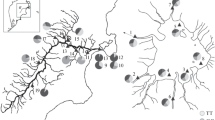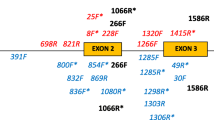Abstract
Polymorphism of the nucleotide sequences encoding 149 amino acids of linked major histocompatibility complex (Mhc) class II 131 and 132 peptides, and of the intervening intron (548–773 base pairs), was examined within and among seven Pacific salmon (Oncorhynchus) species. Levels of nucleotide diversity were higher for theB1 sequence than forB2 or the intron in comparisons both within and between species. For the codons of the peptide binding region of the BI sequence, the level of nonsynonymous nucleotide substitution (dN) exceeded the level of synonymous substitution (dS) by a factor of ten for within-species comparisons, and by a factor of four for between-species comparisons. The excess of dN indicates that balancing selection maintains diversity at this salmonidMhc class II locus, as is common forMhc loci in other vertebrates. Levels of nucleotide diversity for both the exon and intron sequences were greater among than within species, and there were numerous species-specific nucleotides present in both the coding and noncoding regions. Thus, neighbor-joining analysis of both the intron and exon regions provided phylogenies in which the sequences clustered strongly by species. There was little evidence of shared ancestral (trans-species) polymorphism in the exon phylogeny, and the intron phylogeny depicted standard relationships among the Pacific salmon species. The lack of shared allelicB1 lineages in these closely related species may result from severe bottlenecks that occurred during speciation or during the ice ages that glaciated the rim of the north Pacific Ocean approximately every 100 000 years in the Pleistocene.
Similar content being viewed by others
References
Allendorf, F. W. and Thorgaard, G. H. Tetraploidy and the evolution of salmonid fishes. In B. J. Turner (ed.):Evolutionary Genetics of Fishes, pp. 1–53, Plenum Press, New York, 1984
Amemiya, C. T. and Litman, G. W. Early evolution of immunoglobulin genes.Amer Zool 31: 558–569, 1991
Bourlet, Y., Behar, B., Guillemot, F., Frechin, N., Billault, A., Chausse, A. M., Zoorob, R., and Auffray, C. Isolation of chicken major histocompatibility complex class II (B-L) β chain and expression in lymphoid organs.EMBO J 7: 1031–1039, 1988
Broecker, W. S. and Denton, G. H. What drives glacial cycles?Science 262: 48–56, 1990
Brown, J. H., Jardetzky, T. S., Gorga, J. C., Stern, L. J., Urban, R. G., Strominger, J. L., and Wiley, D. C. Three-dimensional structure of the human class II histocompatibility antigenHLA-DR1.Nature 364: 33–39, 1993
Devlin, R. H. Sequence of sockeye salmon type 1 and 2 growth hormone genes and the relationship of rainbow trout with Atlantic and Pacific salmon.Can J Fish Aquat Sci 50: 1738–1748, 1993
Del Pozza, G., Ombra, M. N., Perfetto, C., Barbaro, A. D. L., Autiero, M., Maffei, A., and Guardiola, J.Alu repeats and evolution of theHLA-DQA1 locus. In J. Klein and D. Klein (eds.):Molecular Evolution of the Major Histocompatibility Complex, pp 231–242, Springer, Berlin Heidelberg, 1991
Efron, B. The jackknife, the bootstrap, and other resampling plans. CBMS-NSF regional Conference Series in Applied Mathematics, Monograph 38, SIAM Philadelphia, 1982
Felsenstein, J. Confidence limits of phylogenies: an approach using the bootstrap.Evolution 39: 783–791, 1985
Figueroa, F., Tichy, H., Berry, R. J., and Klein, J. MHC polymorphism in island populations of mice.Curr Top Microbiol Immunol 127: 100–105, 1986
Flajnik, M. F., Canel, C., Kramer, J., and Kasahara, M. Evolution of the major histocompatibility complex: molecular cloning of the major histocompatibility complex class I from the amphibian Xenopus.Proc Natl Acad Sci 88: 537–541, 1991
Gibbs, H. L., Weatherhead, P. J., Boag, P. T., White, B. N., Tabak, L. M., and Hoysak, D. J. Realized reproductive success of polygynous red-winged blackbirds revealed by DNA markers.Science 250: 1394–1397, 1990
Grimholt, U., Olsaker, I., Lindstrom, C., and Lie, O. A study of variability in the MHC class II β1 and class I α2 domain exons of Atlantic salmon (Salmo salar).Anim Genet 25: 1–7, 1994
Hashimoto, K., Nakanishi, T., and Kurosawa, Y. Isolation of carp genes encoding major histocompatibility complex antigens.Proc Natl Acad Sci 87: 6863–6867, 1990
Hordvik, I., Grimholt, U., Fosse, V. M., Lie, O., and Endresen, C. Cloning and sequence analysis of cDNAs encoding the MHC class II β chain in Atlantik salmon (Salmo salar).Immunogenetics 37: 437–441, 1993
Hughes, A. L. MHC polymorphism and the design of captive breeding programs.Conserv Biol 5: 29–251, 1991
Jukes, T. H. and Cantor, C. R. Evolution of protein molecules. In H. N. Munro (ed.):Mammalian Protein Metabolism III, pp. 21–32, Academic Press, New York, 1969
Juul-Madsen, H. R., Glamann, J., Madsen, H. O., and Simonsen, M. MHC class 11 beta-chain expression in the rainbow trout.Scand J Immunol 35: 687–694, 1992
Kido, Y., Aono, M., Yamaki, T., Matsumoto, K.-I., Murata, S., Saneyoshi, M., and Okada, N. Shaping and reshaping of salmonid genomes by amplification of tRNA-derived retroposons during evolution.Proc Natl Acad Sci 88: 2326–2330, 1991
Klein, J.Natural History of the Major Histocompatibility Complex, John Wiley, New York, 1986
Klein, J. Origin of major histocompatibility complex polymorphism: the trans-species hypothesis.Hum Immunol 19: 155–162, 1987
Klein, J. The major histocompatibility complex of the mouse.Science 203: 516–521, 1979
Klein, D., Ono, H., O'hUigin, C., Vincek, V., Goldschmidt, T., and Klein, J. Extensive MHC variability in cichlid fishes of Lake Malawi.Nature 364: 330–334, 1993
Koishi, R. and Okada, N. Distribution of the salmonidHpa 1 family in the salmonid species demonstrated by in vitro runoff transcription assay of total genomic DNA: a procedure to estimate repetitive frequency and sequence divergence of a certain repetitive family with a few known sequences.J Mol Evol 32: 43–52, 1991
Kumar, S., Tamura, K., and Nei, M. MEGA: Molecular Evolutionary Genetics Analysis, ver 1.01. The Pennsylvania State University, University Park, 1993
McGuire, K. L., Duncan, W. R., and Tucker, P. W. Syrian hamster DNA shows limited polymorphism at class L-like loci.Immunogenetics 22: 257–268, 1985
McPhail, J. D. and Lindsey, C. C. Freshwater fishes of northwestern Canada and Alaska.Can J Fish Aquatic Sci Bull 173: 1–381, 1970
Miller, K. M., Withler, R. E., and Beacham, T. D. Stock identification of coho salmon (Oncorhynchus kisutch) using minisatellite DNA variation.Can J Fish Aquat Sci, in press
Nei, M. and Gojobori, T. Simple methods for estimating the numbers of synonymous and nonsynonymous nucleotide substitutions.Mol Biol Evol 3: 418–426, 1986
Nei, M. and Hughes, A. L. Polymorphism and evolution of the major histocompatibility complex loci in mammals. In R. K. Selander, A. G. Clark, and T. S. Whittam (eds.):Evolution at the Molecular Level, pp. 222–247, Sinauer Associates Inc, Sunderland, 1991
Nei, M. and Rzhetsky, A. Reconstruction of phylogenetic trees and evolution of major histocompatibility complex genes. In J. Klein and D. Klein (eds.):Molecular Evolution of the Major Histocompatibility Complex, pp. 14–27, Springer, Berlin, Heidelberg, 1991
O'Brien, S. J., Roelke, M. E., Marker, L., Newmen, A., Winkler, C. A., Meltzer, D., Colly, L., Evermann, J. F., Bush, M., and Wildt, D. E. Genetic basis for species vulnerability in the cheetah.Science 227, 1428–1434, 1985
Ohno, S.Evolution by Gene Duplication, Springer, New York, 1970
Okada, N. SINEs.Current Opinion in Genetics and Development 1: 498–504, 1991
Okamura, K., Nakanishi, T., Kurosawa, Y., and Hashimoto, K. Expansion of genes that encode MHC class I molecules in cyprinid fishes.J Immun 151: 188–200, 1993
Okazaki, T. Genetic variation and population structure in mason salmonOncorhynchus masou of Japan.Bull Japan Soc Sci Fish 52: 1365–1376, 1986
Ono, H., Klein, D., Vincek, V., Figueroa, F., O'hUigin, H., and Klein, J.Mhc class II genes of zebrafish.Proc Natl Acad Sci 89: 11886–11890, 1992
Ono, H., O'hUigin, C., Tichy, H., and Klein, J. Major histocompatibility complex variation in two species of cichlid fishes from Lake Malawi.Mol Biol Evol 10: 1060–1072, 1993
Plante, Y., Boage, P. T., White, B. N., and Boonstra, R. Highly polymorphic genetic markers in meadow voles (Microtus pennsyl-vanicus) revealed by a murine major histocompatibility complex (MHC) probe.Can J Zool 69: 213–220, 1991
Rzhetsky, A. and Nei, M. A simple method for estimating and testing minimum-evolution trees.Mol Biol Evol 9: 945–967, 1992
Rzhetsky, A. and Nei, M. Theoretical foundation of the minimum-evolution method of phylogenetic inference.J Mol Evol 38: 295–299, 1993
Saitou, N. and Nei, M. The neighbor-joining method: a new method for reconstructing phyologenetic trees.Mol Biol Evol 4: 406, 1987
Satta, Y. How the ratio of nonsynonymous to synonymous pseudogene substitutions can be less than one.Immunogenetics 38: 450–454, 1993
Schonbach, C. and Klein, J. The Alu repeats of the primate DRB genes. In J. Klein and D. Klein (eds.):Molecular Evolution of the Major Histocompatibility Complex, pp 243–255, Springer, Berlin Heidelberg, 1991
She, J. X. and Wakeland, E. K. Molecular and genetic mechanisms involved in the generation of Mhc diversity. In J. Klein and D. Klein (eds.):Molecular Evolution of the Major Histocompatibility Complex, pp. 139–154, Springer, Berlin Heidelberg, 1991
Slade, R. W. Limited MHC polymorphism in the southern elephant seal: implications for MHC evolution and marine mammal population biology.Proc R Soc Lond B 249: 163–171, 1992
Takasaki, N., Murata, S., Saitoh, M., Kobayashi, T., Park, L., and Okada, N. Species-specific amplification of tRNA-derived short interspersed repetitive elements (SINEs) by retroposition: a process of parasitization of entire genomes during the evolution of salmonids.Proc Natl Acad Sci 91: 10153–10157, 1994
Thomas, W. K. and Beckenbach, A. T. Variation in salmonid mitochondrial DNA: evolutionary constraints and mechanisms of substitution.J Mol Biol 29: 233–245, 1989
Thomas, W. K., Withler, R. E., and Beckenbach, A. T. Mitochondrial DNA analysis of Pacific salmonid evolution.Can J Zool 64: 1058–1064, 1986
Trowsdale, J., Groves, V., and Arnason, A. Limited MHC polymorphism in whales.Immunogenetics 29: 19–24, 1989
Trowsdale, J. “Both man & bird & beast”: comparative organization of MHC genes.Immunogenetics 41: 1–17, 1995
Utter, F. M., Allendorf, F. W., and Hodgins, H. O. Genetic variability and relationships in Pacific salmon and related trout based on protein variations.Syst Zool 22: 257–270, 1973
Ye, Y., She, J., and Wakeland, E. K. Diversification of class II Au within the genusMus. In J. Klein and D. Klein (eds.):Molecular Evolution of the Major Histocompatibility Complex, pp. 131–138, Springer, Berlin Heidelberg, 1991
Author information
Authors and Affiliations
Additional information
The nucleotide sequence data reported in this paper have been submitted to the GenBank nucleotide sequence database and have been assigned the accession numbers U34692-U34720
Rights and permissions
About this article
Cite this article
Miller, K.M., Withler, R.E. Sequence analysis of a polymorphic Mhc class II gene in Pacific salmon. Immunogenetics 43, 337–351 (1996). https://doi.org/10.1007/BF02199802
Received:
Revised:
Issue Date:
DOI: https://doi.org/10.1007/BF02199802




